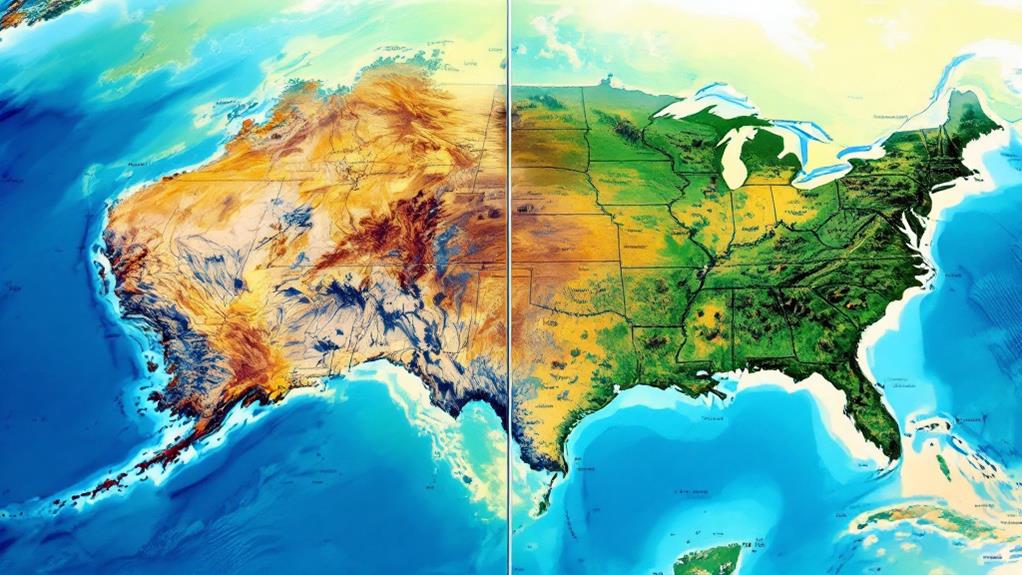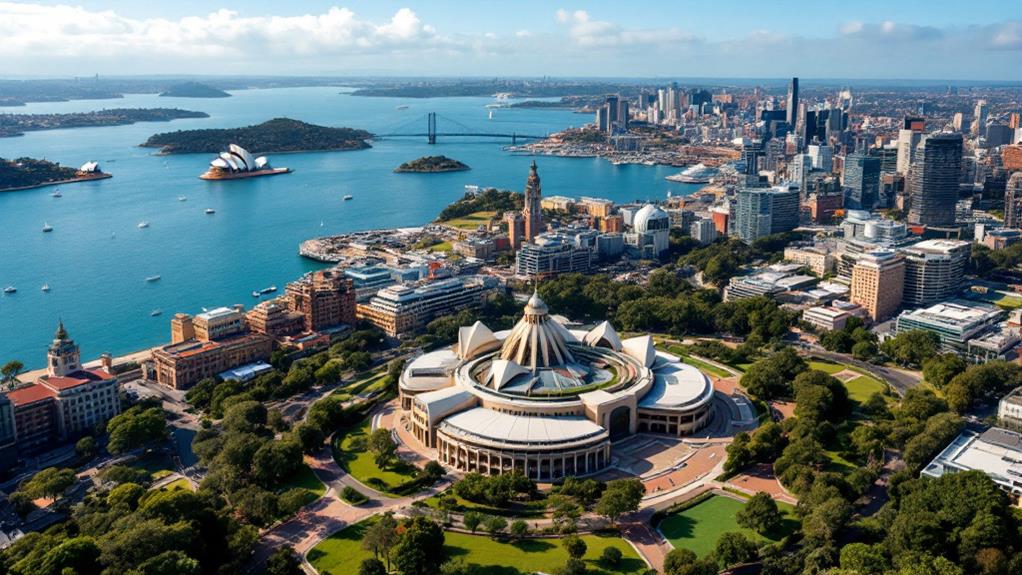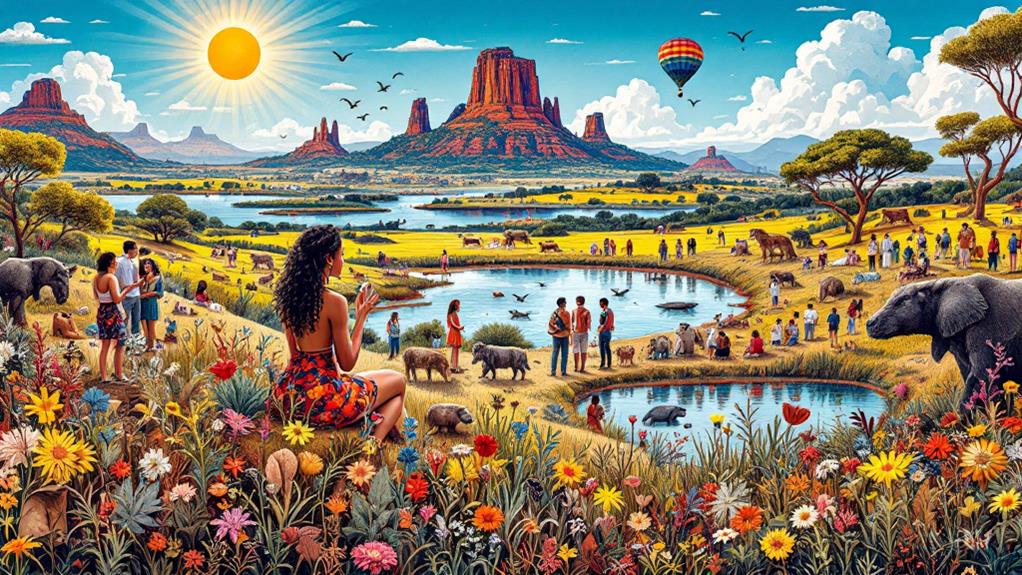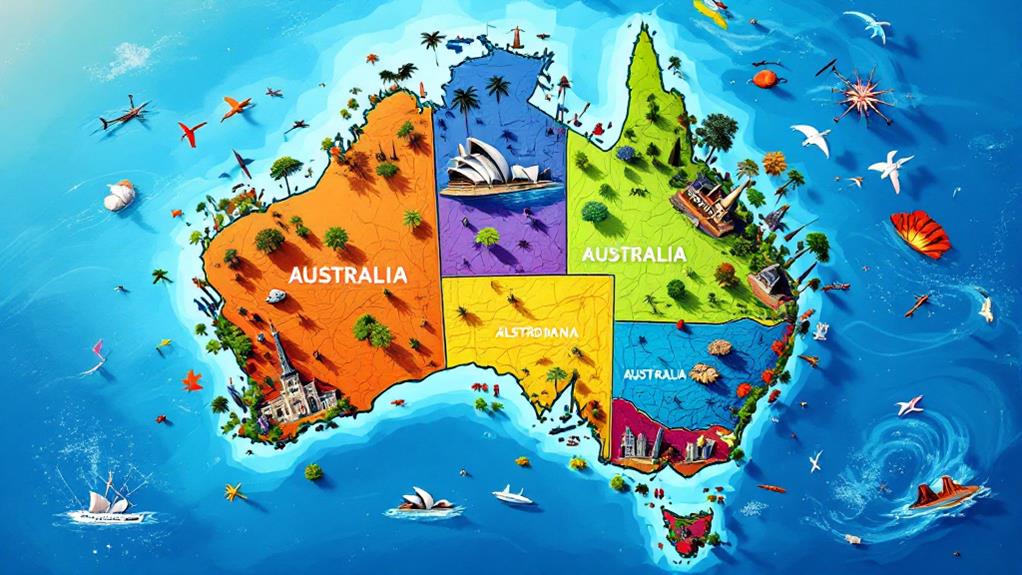How Big Is Australia? Size Comparison and Geographic Facts
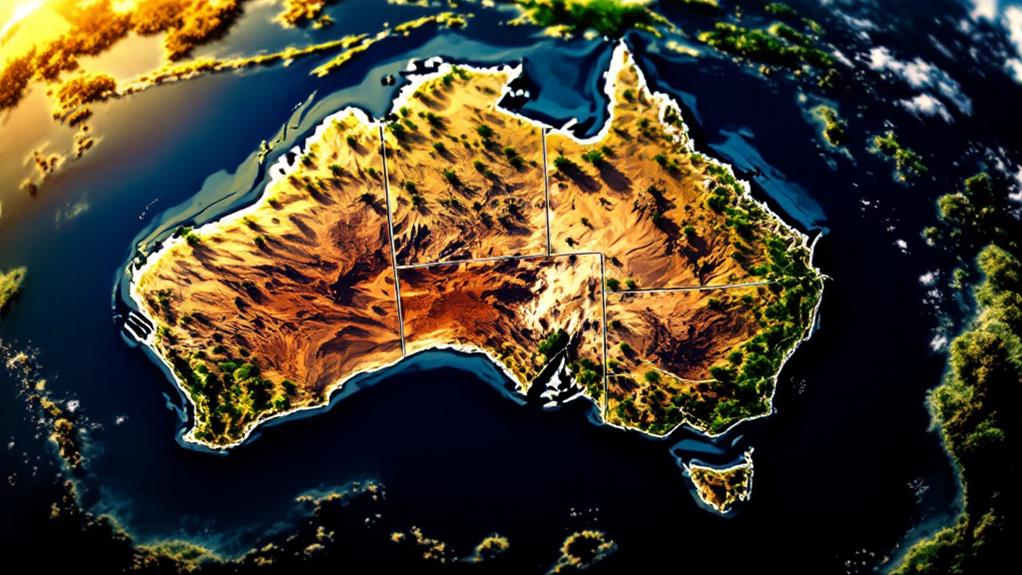
You'll find Australia as the sixth-largest country globally, sprawling over 7,688,287 square kilometers. It's about 5% of the world's land area. Picture it nearly the size of the continental United States. This vast expanse makes Australia both a unique continent and the largest island. Its geographic features are as varied as massive deserts and lush rainforests. Despite its size, Australia's population is a mere 27 million, concentrated mostly along the east coast, with a low population density of 3.4 inhabitants per square kilometer. Explore deeper into this intriguing land with its distinctive climatic zones and fascinating biodiversity.
Australia's Global Size Ranking
Regarding understanding Australia's place on the global stage, its sheer vastness is a key component. As the sixth-largest country in the world, Australia covers an impressive 7,688,287 square kilometers. This massive size places it above other large countries like India and Argentina. In fact, Australia's land area accounts for roughly 5% of the world's total land area, which is quite significant considering the planet's vast expanse. It's fascinating to note that Australia is almost as large as the continental United States, which spans about 9.8 million square kilometers, highlighting just how expansive the country truly is.
Despite its enormous land size, Australia maintains a surprisingly low population density, with only about 3.4 inhabitants per square kilometer. This low density is particularly intriguing given the country's size, setting it apart from other large nations with much higher population concentrations. Furthermore, Australia's unique status as both a continent and an island adds to its distinctiveness on the global map. This combination of vastness and singularity in its geographic identity makes Australia's global size ranking a remarkable aspect of its comprehensive character, setting a foundation for its diverse ecological and cultural environments.
Geographic Features and Diversity
Although Australia's vastness is a defining characteristic, its geographic features and diversity truly immerse it apart. As the sixth-largest country in the world, covering around 7,688,287 square kilometers, Australia is a land of extremes and contrasts. Despite being the largest country in Oceania, it's also the smallest continental landmass, distinctly positioned between the Indian and Pacific Oceans. This duality gives rise to an astonishing array of geographic features.
You'll find arid deserts like the Simpson Desert coexisting with lush tropical rainforests in Queensland, each harboring distinct ecosystems. The coastal regions offer yet another layer of diversity, with lively marine life, thanks to the Great Barrier Reef—one of the world's most iconic natural wonders. In the heart of Australia, landmarks like Uluru and Mount Kosciuszko stand as monuments to the country's exceptional natural beauty and biodiversity.
Australia's climate is similarly varied. With an average annual rainfall under 500 mm, it holds the title of the driest inhabited continent. Vast portions are arid or semi-arid, yet its biodiversity thrives, showcasing a remarkable balance between land and life. This geographic diversity is a reflection of Australia's distinctive place in the world.
Land Area and Comparisons
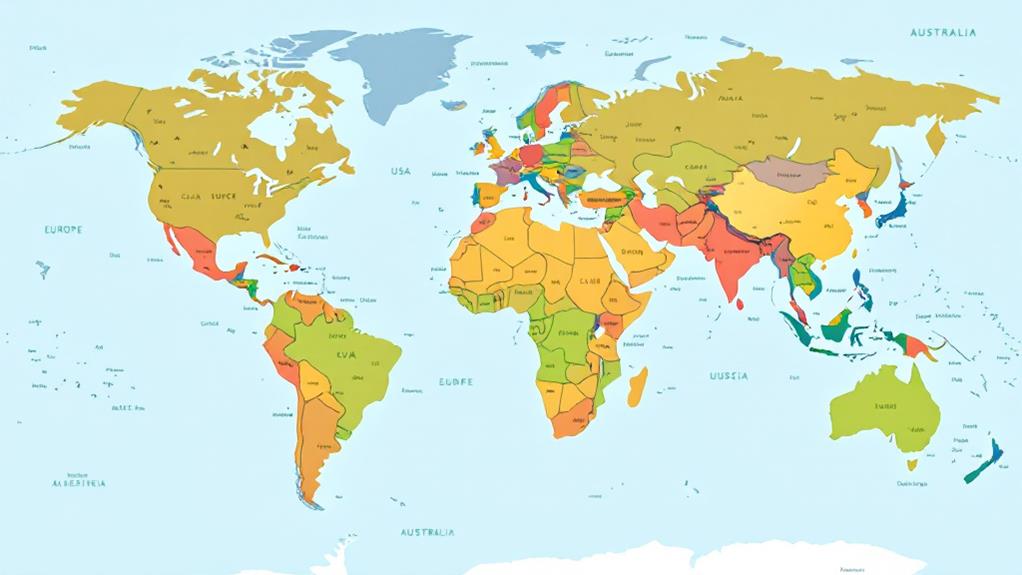
You might be surprised to learn that Australia's land area is a massive 7,688,287 square kilometers, making it the sixth-largest country in the world. This vast expanse is comparable to the continental United States, which covers about 9.8 million square kilometers. Despite being slightly smaller, Australia's land area still holds a significant place on the global stage.
As the largest island worldwide, Australia also claims the title of the smallest continental landmass. Its unique position in the southern hemisphere, surrounded by oceans, contributes to its diverse geography. Western Australia alone spans an impressive 2.65 million square kilometers, surpassing the combined size of Texas and Alaska, which is approximately 2.41 million square kilometers. This highlights just how large even individual regions within Australia can be.
Australia's land area accounts for 5% of the world's total land area, underscoring its substantial geographic footprint. Its sheer size offers a variety of landscapes, from arid deserts to lush rainforests, all of which play an integral role in its identity. Understanding Australia's vast land area helps you appreciate the scale and diversity that define this remarkable country.
Population and Density Insights
Australia's vast land area contrasts sharply with its relatively small population. Despite Australia's expansive size, its population is considerably lower than that of many other countries. With around 27 million residents, Australia doesn't come close to the USA's population of over 333 million. This discrepancy becomes even more apparent when you consider that Texas alone, a single U.S. state, has approximately 29 million people.
Australia's average population density is about 3.4 inhabitants per square kilometer, making it one of the least densely populated countries globally. Most Australians live in urban areas along the east coast, with cities like Sydney and Melbourne each housing over 5 million residents. This urban concentration leaves vast inland areas sparsely inhabited, highlighting the country's striking population distribution.
In your mind, imagine:
- Endless stretches of open land, with few signs of human habitation.
- Bustling urban centers on the east coast, teeming with activity.
- The vastness of Australia's interior, where silence reigns.
- Skyscrapers and city lights contrasting with the starry outback sky.
- Coastal cities that host nearly 89% of the population, thriving with life.
Australia's population is considerably urbanized, yet its heartland remains largely untouched.
Climate Variations Across Regions
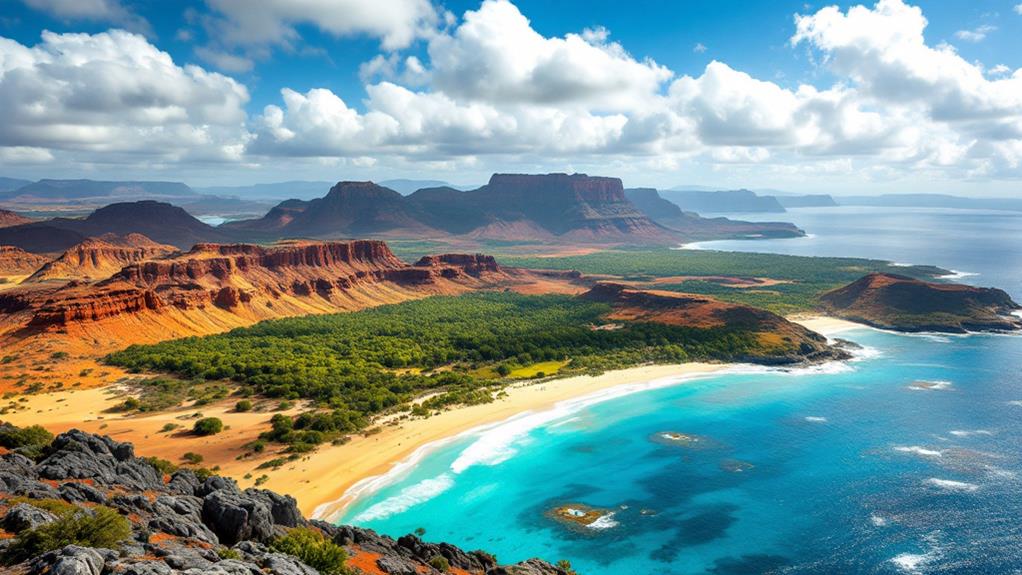
From the lush tropics of the north to the temperate regions of the south, Australia's climate showcases remarkable immersion. You'll find a spectrum of climate variations across this vast land. In the north, regions like Cape York bask in a tropical climate, characterized by warm temperatures and seasonal rainfall. As you venture south, places like Melbourne offer a temperate climate, where cooler weather prevails, bringing a distinct contrast to the tropical north.
Australia's diverse climate greatly impacts its population distribution. Most of Australia's population gravitates towards the more hospitable coastal regions, especially along the eastern seaboard. These areas enjoy a moderate climate, thanks to the ocean's influence, making them appealing for both living and tourism. The coast's milder conditions also favor agriculture, supporting the nation's food production.
In stark contrast, the interior, known as the outback, presents an arid and semi-arid climate. Here, you'll encounter extreme temperature fluctuations, with blistering summers and chilly winters. The average annual rainfall across Australia is less than 500 mm, underscoring its status as the driest inhabited continent. These climatic factors shape how and where people reside, emphasizing the interplay between environment and Australia's population.
Travel Infrastructure and Distances
Traversing Australia's immense landscape often presents unique challenges due to the country's vast size and sparse population. The sheer scale, with around 7.7 million square kilometers of land, means you'll face significant travel distances, like the 2,500 miles between Darwin and Sydney. This large expanse, combined with an average population density of just 3.4 people per square kilometer, directly impacts travel infrastructure.
You'll find fewer flights, ferries, and trains connecting the major cities. The distance from Sydney to Perth rivals that of a cross-country trip in the United States from New York to Los Angeles. With such distances, planning becomes crucial. Transport services often run on a reduced schedule, sometimes offering connections only once a day, demanding precise timing on your part.
Consider these points to visualize the expedition:
- Long stretches of road through the Outback with minimal stops.
- Sparse flight schedules necessitating early bookings.
- Limited train services that could mean overnight travels.
- Vast distances between rest stops or refueling stations.
- Remote locations often requiring alternative transport methods.
Realistic expectations about travel times and potential disruptions will help you navigate this vast, beautiful country more smoothly.
Environmental and Biodiversity Highlights
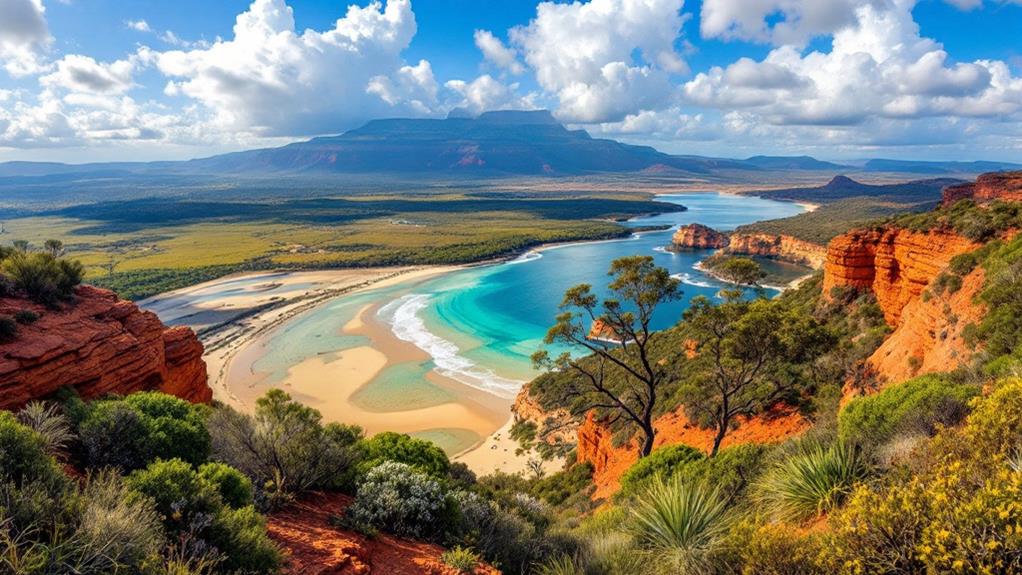
Australia dazzles with its unique environmental and biodiversity highlights, making it a haven for nature enthusiasts. Imagine exploring a land where kangaroos and koalas roam, creatures found nowhere else on Earth. Australia's remarkable biodiversity stems from its position as the world's smallest continent and sixth-largest country, covering about 7,688,287 km². Despite its vastness, Australia's population is concentrated in urban areas, allowing its diverse ecosystems to flourish.
The Great Barrier Reef, the largest coral reef system globally, stretches over 2,300 kilometers off Australia's northeast coast. It's a marine wonderland, teeming with life and attracting visitors worldwide. However, like many natural wonders, it faces significant environmental issues, including climate change and pollution, threatening its lively ecosystem.
Australia's classification as the driest inhabited continent, with less than 500 mm of average annual rainfall, creates a mosaic of environments from arid deserts to lush rainforests. Yet, over 1,800 species are listed as threatened, underscoring the urgent need for conservation efforts. Balancing the needs of Australia's population with the preservation of its natural heritage is essential to maintaining this extraordinary land's unique biodiversity.
Historical and Cultural Overview
Though the land's natural beauty is enchanting, Australia's rich history and dynamic culture offer even more depth to investigate. Australia is home to one of the world's largest and oldest continuous cultures, with Indigenous habitation dating back 50,000 to 65,000 years. It's fascinating to think about the approximately 250 distinct Aboriginal language groups that thrived here long before European contact. The initial encounter with Europeans came when Dutch navigator Willem Janszoon arrived in 1606. Later, Captain James Cook claimed eastern Australia for Great Britain in 1770. These events laid the groundwork for the First Fleet's arrival in New South Wales on January 26, 1788, now celebrated as Australia Day.
Australia's expedition to becoming the Commonwealth of Australia in 1901 marked a significant moment in its history. The country's active participation in both World Wars further shaped its national identity and contemporary society.
Imagine the cultural tapestry:
- Ancient rock art painted by Aboriginal hands.
- Lively celebrations on Australia Day.
- Historic battlefields from World War engagements.
- The harmonious blend of British influences in modern Australia.
- The colorful stories shared through Indigenous storytelling.
Such a rich cultural history unites Australia and the United Kingdom with deeply interwoven historical ties.

